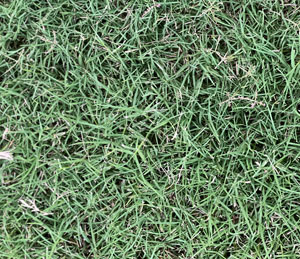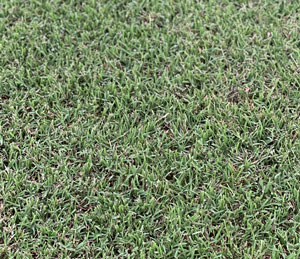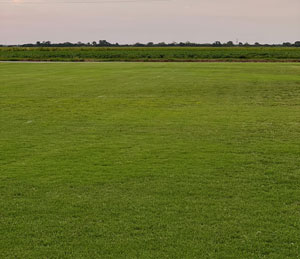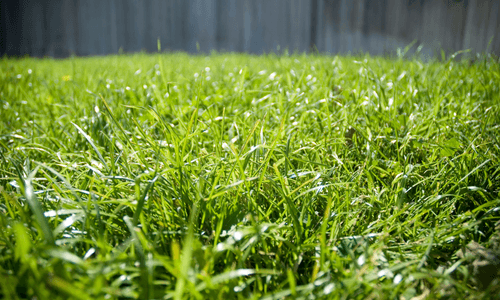Bermudagrass – Lawn Care in Arkansas
Fast Facts about Bermudagrass (Cynodon spp.)
- Bermudagrass is the most commonly used lawn grass in Arkansas.
- It will grow on a wide range of soil types as long as there is adequate drainage and plenty of sunlight.
- Bermudagrass is not a shade-tolerant turfgrass. Full sun is required for it to thrive.
- Durability and the ability to recover quickly make it the first choice for hightraffic areas.
- It has good drought tolerance. Established bermudagrass will turn brown during extended dry periods but recover after the first significant rainfall.



Rapid Growth Rate of Bermudagrass

The quick growth rate of bermudagrass, compared to slower growing grasses like zoysiagrass and centipedegrass, makes bermudagrass the most affordable turfgrass to purchase as sod. Rapid growth means frequent mowing during June, July and August. Mowing frequency is also tied to nitrogen fertilization and rain fall or irrigation.
Because bermuda grass is a fast grower that produces rhizomes and stolons, it readily invades ornamental beds, gardens and requires frequent edging along walks and driveways. The aggressive properties that make it a desirable turfgrass also make it a major weed.
What are the differences between hybrid and common bermudagrass varieties?
The hybrid bermudagrasses (Cynodon dactylon × C. transvaalensis) are generally finer textured than common bermuda grass (Cynodon dactylon) and must be started from sod, sprigs or plugs. Common bermudagrass is typically seeded.
The biggest problem homeowners have with hybrid bermudagrasses is the inability to
mow them correctly.
Hybrid bermudagrasses look best when mowed three times per week at 0.5 to 1.5 inch
with a reel mower. Because this isn’t practical for most homeowners, a seeded bermudagrass
is often a better choice.
Hybrid varieties include ‘Tifway’ (Tifton 419), ‘TifSport’, ‘Patriot’ and many others. Tifway is a hybrid released in 1960 from the USDA research station in Tifton, Georgia. Tifway is available from many sod farms in Arkansas.
After years of nothing but ‘Arizona Common’ bermudagrass on the market, the quality of seeded bermudagrasses has improved dramatically since 2000. New seeded varieties such as ‘Riviera’ and ‘Yukon’ (developed at Stillwater, Oklahoma) are a good choice for lawns in Arkansas. They are attractive, cold-tolerant grasses that are well adapted in all parts of the state.
‘Princess77’ (from New Mexico) is a seeded, fine-textured variety that approaches the quality of the ‘Tifway’ hybrid, but lacks sufficient cold tolerance for use in north Arkansas. Many other cultivars are also available. For more information on seeding a lawn, see Seeding a Lawn in Arkansas, FSA2113.
What are the recommended maintenance practices for bermudagrass?
Proper maintenance practices will help you care for your lawn throughout the year. Because every site is different due to variations in location, terrain, soil type, condition of lawn, previous lawn care and other factors, adjust these practices and dates to suit your home lawn.
Twelve Month Calendars for Bermudagrass Care
The tables below show the optimum time period to perform various maintenance practices to your bermudagrass lawn. The optimum lawn maintenance period may be started earlier or extended based on variations in annual weather conditions and/or location in Arkansas.
- A is displayed for an Acceptable month for the designated task.
- B is displayed for the Best month for the designated task.
|
Task |
Jan |
Feb |
Mar |
Apr |
May |
Jun |
Jul |
Aug |
Sep |
Oct |
Nov |
Dec |
||
|---|---|---|---|---|---|---|---|---|---|---|---|---|---|---|
|
Watering |
|
|
|
A |
A |
B |
B |
B |
A |
A |
|
|
||
|
Mowing |
|
|
|
A |
B |
B |
B |
B |
B |
A |
|
|
||
|
Fertilization |
|
|
|
A |
B |
B |
B |
B |
A |
|
|
|
||
|
Liming |
|
A |
B |
B |
A |
|
|
|
A |
B |
B |
A |
||
|
Aeration |
|
|
|
A |
B |
B |
B |
B |
A |
|
|
|
||
|
Dethatching |
|
|
|
A |
B |
B |
B |
A |
|
|
|
|
||
|
Seeding |
|
A |
B |
B |
B |
A |
|
|
|
|
|
|
||
|
Sodding |
|
A |
A |
B |
B |
B |
B |
B |
B |
A |
A |
A |
||
|
Control Measure |
Jan |
Feb |
Mar |
Apr |
May |
Jun |
Jul |
Aug |
Sep |
Oct |
Nov |
Dec |
|
|---|---|---|---|---|---|---|---|---|---|---|---|---|---|
|
Preemergence- |
A |
B |
B |
A |
|
|
|
|
|
|
|
|
|
|
Postemergence- |
|
|
A |
B |
B |
B |
B |
|
B |
B |
A |
|
|
|
Postemergence- |
|
|
|
A |
B |
B |
B |
A |
|
|
|
|
|
|
Postemergence- |
|
|
|
|
|
|
|
|
|
|
B |
B |
|
Seasonal Recommendations and Care Tips for Arkansas Bermudagrass
Below you can browse specific seasonal maintenance practices and resources that will help you care for your lawn throughout the year.
March through May Bermudagrass Care
Before bermudagrass begins to grow in the spring, you may mow the turf slightly shorter than normal to remove dead leaf blades and other debris. This practice will reduce shading of the emerging plants and also serve to warm soil temperatures more quickly in the spring. Begin mowing regularly when the grass turns green in the spring and reaches the desired mowing height.
Bermudagrass should be mowed at 0.5 to 2.5 inches. Hybrid bermudagrass cultivars should be mowed at heights from 0.5 to 1.5 inches. Common bermudagrass should be mowed at 1.5 to 2.5 inches. Higher mowing heights may be needed on uneven lawns to avoid scalping. Mow often to avoid removing more than onethird of the leaf blade.
It isn’t necessary to collect clippings unless they remain as clumps on the lawn surface. Mowing more frequently to avoid clipping buildup is more efficient than emptying the collection bag.
For more information about mowing, see Mowing Your Lawn, FSA6023.
Apply 0.5 to 1.0 pound of nitrogen per thousand square feet approximately three weeks after the grass turns green in late May. Submit a soil sample to determine phosphorus and potassium requirements, if you haven’t already (contact your county Extension office). Apply lime if suggested. For more information about soil pH in lawns, see Liming Your Lawn, FSA6134.
To determine the amount of fertilizer product required to apply 1.0 pound of nitrogen per thousand square feet, divide 1.0 by the first number (%) in the fertilizer ratio. For example, for a 2055 fertilizer (containing 20% nitrogen), divide 1.0 by 0.20 (NOTE: 20% = 0.20). The result is 5 pounds of product per thousand square feet. For more information about fertilization and calculating the amount of fertilizer you need to apply, see Fertilizing Your Lawn, FSA2114.
Apply preemergence herbicides to control crabgrass in late February or early March. Control broadleaf weeds with a postemergence application of a two or threeway herbicide containing 2,4D + dicamba and/or MCPP (Ortho® WeedBGon®). Do not exceed two applications per year of a two or threeway herbicide containing 2,4D + dicamba and/or MCPP with a minimum of 30 days between applications.
Use a product containing quinclorac for postemergence crabgrass control. Use SedgeHammer® (halosulfuron) for post emergence control of sedges.
For weed pictures and more control information, find Turfgrass Weed Control, MP521. See page 8 for crabgrass control, page 16 for sedge control and pages 11, 13 and 17 for broadleaf control.
Small (1 to 3inch) circular, shaded, strawcolored spots in your lawn appearing several weeks after greenup are likely an indicator of the disease dollar spot. Larger dead spots (1 to 3 feet) in diameter appearing during spring greenup and for several weeks following likely indicate the presence of spring dead spot.
For more information about these diseases, see FSA7541, Dollar Spot of Turfgrass in the Home Landscape, and FSA7551, Bermudagrass Spring Dead Spot.
Replant large bare areas using sod or plugs planted on 6 or 12inch centers. Applying a preemergence herbicide that does not interfere with root growth after plugging helps prevent weed encroachment.
Common bermudagrass can be seeded at 0.5 to 1 pound per thousand square feet in lawns not treated with a preemergence herbicide within the previous two months.
June through August Bermudagrass Care
Water early in the morning to wet the soil to a depth of 4 to 6 inches. Probe with a screwdriver to determine moisture depth. Bermudagrass needs a weekly application of 1 to 1.25 inches of water to retain its color during summer. It needs even less to survive and can go several weeks without supple mental irrigation.
On sandy soils, it requires more frequent watering: for example, 0.5 inch of water every third day. It is often necessary to irrigate an area for three to five hours to apply 1 inch of water with most homeowner irrigation systems. (It takes 620 gallons of water to apply 1 inch of water per thousand square feet.)
Because clay soils accept water slowly, irrigate these areas until runoff occurs; wait onehalf hour until the water has been absorbed, and then continue irrigating until the desired depth or amount is obtained. A dark, bluish gray color, footprinting and wilted, folded or curled leaves indicate that it is time to water.
Thatch needs to be removed every two to three years through core aerification or dethatching. Cultivation during the early summer is preferred because moisture is usually not limiting and growth is optimum for recovery.
For more information about thatch, see Thatch Prevention and Control, FSA6139.
Apply postemergence herbicides as needed to control summer broadleaf weeds such as spurge, knotweed and lespedeza. For postemergence crabgrass control, apply a product containing quinclorac. Make two applications 14 days apart. Use SedgeHammer® (halosulfuron) for sedge control.
Apply post emergence herbicides only when weeds are present, the lawn is actively growing and not suffering from drought. To improve annual bluegrass control, apply a preemergence herbicide on August 15 and water in immediately.
Replant large bare areas using sod or plugs planted on 6 or 12inch centers. Applying a preemergence herbicide that does not interfere with root growth after plugging helps prevent weed encroachment.
Common bermudagrass can be seeded at 0.5 to 1 pound per thousand square feet. Seeding in spring or early summer will enhance the winter hardiness of bermudagrass seedlings.
September through November Bermudagrass Care
Apply no more than 0.5 pound of nitrogen per thousand square feet in September, four to six weeks before the first expected frost. Potassium can be applied if soil tests indicate a need. If potassium is needed, use a lownitrogen, highpotassium fertilizer such as a 10040 or supplement a nitrogen fertilizer source with 1 pound of potash using 1.6 pounds of muriate of potash (0060) per 1,000 square feet.
Several manufacturers offer winterizing fertilizers with various combinations of nutrients. When using these products, try to find one that approximates at 416 ratio of nitrogenphosphorouspotassium and contains iron, which will extend color into fall.
Apply lime during these months if recommended by your soil test.Some diseases such as spring dead spot are active in the fall despite the fact that no symptoms are visible. If your lawn has a history of spring dead spot, fall applications of fungicides may be beneficial.
For more information about this disease, see FSA7551, Bermudagrass Spring Dead Spot.
December through February
Do not fertilize bermudagrass that has not been overseeded. For overseeded bermudagrass, apply 1⁄2 pound of nitrogen per thousand square feet in December and February. In the absence of a soil test, use a complete (NPK) turfgrade fertilizer with a 312 or 412 ratio (for example, 1248 or 24612). Submit soil samples for analysis every 23 years to determine your lawn’s nutrient requirements. Be sure to specify your lawn species.
Control winter broadleaf weeds such as henbit, chickweed, spurweed and hop clover with a post emergence application of a two or threeway herbicide containing 2,4D + dicamba and/or MCPP (Ortho® WeedBGon®). Do not exceed two applications per year of a two or threeway herbicide contain ing 2,4D + dicamba and/or MCPP with a minimum of 30 days between applications.
Apply postemergence herbicides only when weeds are present. Do not use glyphosate for winter weed control in bermudagrass unless it is completely dormant (no sign of green on any part of the plant). Do not use glyphosate unless it can be applied uniformly at 0.5 pounds of active ingredient per acre at a water volume between 10 and 30 gallons per acre.